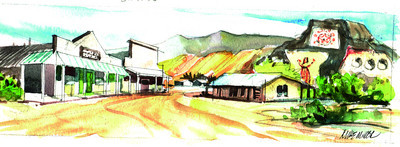Trip to Chloride takes visitors back to the Old West

Old Chloride settles comfortably into this scenic location at the base of the Cerbat Mountains in northern Arizona. The high desert, deep canyons and rugged mountains surround Chloride with a setting familiar after 145 years. The town’s beginnings came with mining ventures when Arizona was a frontier territory in the early 1860s. Today Chloride trades on its Old West past to provide itself with a future.
Accessible in a drive of about an hour and a half from Las Vegas, Chloride lies 80 miles distant. To reach it, follow U.S. 93 over Hoover Dam into Arizona. After you pass the Meadview-Pierce Ferry junction, continue eight miles to the turnoff to the town on Chloride Road. This side road takes you four miles to Chloride’s main street.
Because of continuing road construction on both sides of the Colorado River near the dam, plan your trip for as early in the morning as possible, especially on weekends and holidays. Allow yourself a little extra time to pull off in areas along the roadside where the desert presents a flower show this spring. Walk among the flowers and take plenty of photos. Experts deem the wildflower show spotty, but still better than average because of adequate winter rain.
Chloride considers itself the oldest continuously inhabited mining town in Arizona. Certainly its post office, first opened in 1873, remains the state’s oldest in continuous operation, although it has changed locations over the years. Prospectors found signs of the area’s mineral wealth as early as the 1840s, but its remoteness and hostile native occupants curtailed mining and settlement. Born in 1863, the infant town clung to life until a treaty with the Hualapai people in 1870 allowed it to thrive.
Dozens of mines opened in the area. The need for mills and smelters grew. Attracted by the availability of jobs and the promise of wealth, people flocked to the area, settling in half a dozen camps near Chloride. They came on foot, by horseback or on the stage line that began regular service in 1868. The Santa Fe Railroad laid track from Kingman in 1898. The little depot remains, but train service ended in 1935. Modern roads followed part of the old stage route.
Chloride and other little towns vied for political supremacy in battles to become the county seat, which finally went to Kingman. Chloride’s heyday population reached about 2,000. Of those early mining towns, only Chloride survives with a current population of about 250, mostly retirees and urban refugees seeking the laid-back life the desert offers.
Several old buildings survive from Chloride’s past. Many others were lost to time or fire, that scourge of so many Western towns hastily constructed of wood. A sturdy rock building reputedly once housed a covey of soiled doves. The tiny jailhouse incarcerated early troublemakers. The little bank building and other old structures continue to stand, repurposed to meet the community’s needs. These and other buildings house cafes, a convenience store, gift and souvenir shops and a fire station. One restaurant touts a few guest rooms for overnighters.
Chloride’s chamber of commerce promotes special events during the year to draw tourists. Weekend gunfights and skits engage crowds at Cyanide Springs, a recreated street from the Old West, Hollywood style. Gunfight performers include the Wild Roses, an all-female group. Check for upcoming events on the Internet at www.chlorideaz.com.
Chloride residents point visitors toward a curiosity located just outside town. In a side canyon strewn with huge boulders, visitors find both ancient and modern rock art. Because of the rough road, park your car at the mouth of the canyon and walk up through the boulders to see the rock art.
Native people long ago marked the site with petroglyphs incised into the rock surfaces, probably as a mark of respect for the canyon’s life-giving water. About 40 years ago, the boulders became canvasses for desert murals and mosaics created by Southern Nevada artist Roy Purcell. Enjoy more of Purcell’s work during art walks scheduled the first Saturday of each month in Chloride.
Margo Bartlett Pesek’s column appears on Sundays.